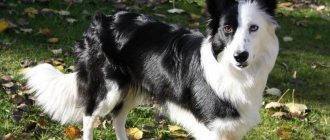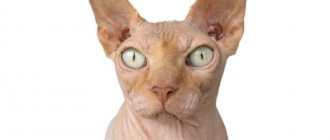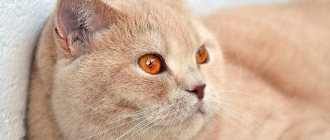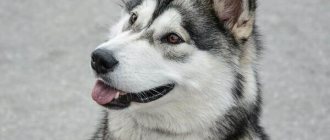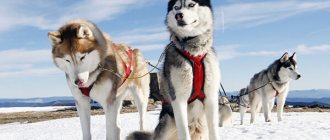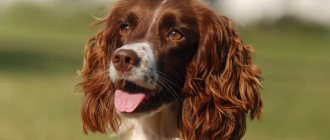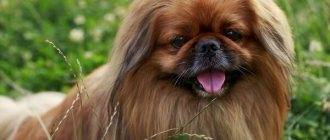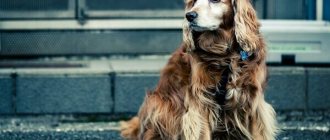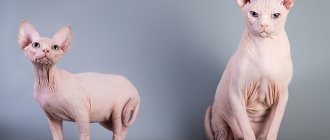The Dalmatian is a dog famous all over the world thanks to the Disney cartoon. This is a devoted and active companion, a true friend for all family members. He has a recognizable bright appearance with a characteristic spotted pattern on his white coat. This is a kind, sociable and cheerful dog. But it also has disadvantages, which can cause problems for inexperienced dog breeders. Therefore, you should not get a Dalmatian without first studying the characteristics of the breed, its pros and cons, and reviews from the owners.
- Head
- Education and training
- Care
Breed traits
Breed traits (on a 5-point scale)
| Dalmatian | |||
| Activity | in the house | 3.8 | |
| on the street | 4.6 | ||
| Obedience | training | 3.1 | |
| strangers | 3.7 | ||
| Domination | in family | 3.1 | |
| over dogs | 3.8 | ||
| Defending your territory | from people | 3.6 | |
| from dogs | 4 | ||
| Sociability | in family | 4.3 | |
| with strangers | 2.7 | ||
| with dogs | 2.6 | ||
| Concentration | in family | 1.8 | |
| in front of strangers | 2.5 | ||
| with dogs | 2.1 | ||
| Aggressiveness | in family | 2.3 | |
| to strangers | 3.2 | ||
| to the dogs | 3.5 | ||
| to cats | 3.3 | ||
| Family behavior | calmness | 3.3 | |
| demand for affection | 4 | ||
| excitability | 4.2 | ||
| playfulness | 4.1 | ||
| excessive barking | 2.8 | ||
| behavioral breakdowns | 2.9 | ||
| Tolerance for children | up to 4 years | 2.9 | |
| over 4 years old | 3.3 | ||
| Institutional use | watchman | 4.2 | |
| bodyguard | 3.2 | ||
This breed is often compared to the following dog breeds: Doberman Pinscher, Labrador Retriever, Great Dane, German Shepherd, Siberian Husky.
The photo shows what a Dalmatian looks like:
Dalmatian
Dalmatian
Adult Dalmatian
Teenager
General characteristics of the Dalmatian dog breed
These smart, active and cheerful dogs make good companions for active owners. Their memorable appearance attracts attention, and their friendliness and lack of aggression makes it possible for families with children to have such a pet. This is an ancient breed that has been known for several thousand years. But it gained wide popularity in the 60s of the 20th century thanks to the cartoon “101 Dalmatians”. It shows the ideal pet, loyal and intelligent.
The Dalmatian can truly make the best family dog. He loves people, is able to understand their mood and give joy. But for this he needs to be raised correctly. In fact, this dog has a complex independent character. He can be stubborn and requires a lot of attention. Only an experienced dog breeder can raise this dog to be a wonderful companion. And his high intelligence, natural kindness and ability to empathize make him a good rescuer and service dog.
| Options | Characteristic |
| breed name | dalmatian (Dalmatian) |
| country of origin | Croatia |
| year of registration | 1926 |
| group of breeds according to the ICF classification | hounds |
| application | hunting dog, companion |
| life expectancy | 10-13 years |
| height | males 56-62 cm, females 54-60 cm |
| weight | males 27-32 kg, females 24-29 kg |
| character traits | playful, sensitive, cheerful, willful, touchy |
| aggressiveness | non-aggressive, but may be suspicious of strangers |
| attitude towards a person | loyal, need attention, do not tolerate loneliness well |
| intelligence | very smart, easy to train |
| difficulty of care | Sheds a lot, no dog smell |
| activity | very active, energetic, requires physical activity |
What is the correct name of the breed?
The name of the breed comes from the region of Dalmatia on the Balkan Peninsula. But earlier this dog was called Dalmatian dog, brindle dog, Danish hound, harlequin. The modern name did not take hold immediately.
There is still debate as to which is correct: Dalmatian or Dalmatian. The first option is often used. But this can be called a person born in Dalmatia. In relation to the breed, the name Dalmatian would be more correct.
pros
These dogs gained wide popularity not only thanks to the Disney cartoon. This dog really has many positive qualities. If raised correctly, she will be an ideal pet and companion. Dalmatians have the following advantages:
- expressive, attractive appearance;
- good-natured, cheerful character;
- they are sociable and make contact well;
- easy to learn, quick-witted;
- treat children well;
- loyal, affectionate, love people and know how to empathize;
- strong, resilient, can make independent decisions, thanks to which in a dangerous situation they can save the owner’s life;
- live peacefully with other pets;
- balanced, resistant to stress;
- do not show aggression;
- with proper upbringing, it is an easy-going, obedient dog.
Minuses
But the breed is not suitable for everyone. Elderly people, homebodies and those who are away from home for a long time should not have it. This dog is quite large and active, so it is difficult to keep it in a city apartment. She requires constant attention and great physical activity. Those who want to get a Dalmatian need to know its disadvantages:
- noisy, often raises his voice;
- early socialization and strict education are required, otherwise the dog will become uncontrollable;
- you need to walk for a long time, run, without physical activity the dog can destroy the house;
- stubborn, strives to dominate;
- may be vindictive and touchy;
- The fur sheds a lot.
The video will tell you about the pros and cons of these dogs:
Video: Pros and cons of the breed.
Video: Dalmatians: features of the breed.
Video: Dalmatian.
Dalmatian training
The dog has great strength and endurance and requires daily physical activity. Play can be considered the most effective method of raising Dalmatians. The dog reacts poorly to food reinforcement, so praise and objects that are used during training (toys, sticks, plastic discs) can be used as reinforcement.
First of all, the dog must remember its name and master the “place” command. After this, you can move on to working on other commands. The dog usually masters the general training course in a few months.
Dalmatians really enjoy agility (obstacle courses). Already at 9 months, the animal independently navigates difficult routes and overcomes various obstacles. If you have several Dalmatians, then you can involve an experienced instructor in the training.
History of the origin of the breed
Dogs that look like modern Dalmatians have been known since ancient Egypt. Descriptions of spotted dogs are found in documents from different countries and eras. There are many images of such dogs dating back to the 16th century. Usually in the drawings they were chasing prey or sitting next to hunters. The earliest mentions of spotted dogs in history were found in Dalmatia. This region, now part of Croatia, is recognized as the homeland of Dalmatians.
English breeders started talking about the breed officially in the 18th century. Already in documents of that time it was called Dalmatian. The British were breeding these dogs, which were also called Italian. White English terriers, pointers, and Great Danes were used in the selection.
These dogs were usually used to hunt birds and wild boar. Their endurance and sensitive sense of smell allowed them to run long distances and smell prey from afar. Then people noticed these dogs' ability to tirelessly run long distances. They began to be used to escort and guard carriages on long journeys. Because of this, they were also called carriage dogs. For a dog to fit under the carriage, its height must be no more than 60 cm.
When Dalmatians came to the United States, they began to help fight fires. They were used as a siren in front of a fire carriage. Until now, this dog is a symbol of firefighters and is used in rescue and search operations. Dalmatians are hunters, shepherds, and rescuers. Thanks to their artistry, in the Middle Ages they often performed in traveling circuses. And after the release of the cartoon “101 Dalmatians” in the early 60s of the 20th century, they began to be used as companions.
In Great Britain and the USA the breed was recognized at the end of the 19th century. Dalmatians began to participate in exhibitions, and the first breed standard was created. But it was officially recognized by the International Canine Association in 1926. The breed appeared in Russia only in the 80s of the 20th century, but did not immediately become popular.
The video will tell you about the history and characteristics of dogs of this breed:
Video: Interesting facts.
Video: Interesting facts about the breed.
Interesting Facts
- Dalmatians served in the English fire brigade. They ran in front of the horse-drawn carriage and barked loudly, scaring passers-by. Dalmatians actually served as special signals that are installed on modern fire trucks.
- The dark spots on the Dalmatian's body range in size from 3 to 6 centimeters.
- Dogs love to lick their owner's face. Thus, they express their joy and gratitude.
- One litter can have Dalmatians with three different colors (brown, black, white).
- Fans of the breed are Salma Hayek, Monica Bellucci, Robert De Niro and other famous actors.
- According to ancient Indian legend, the Dalmatian was the result of a meeting between a Bengal tiger and a dog.
- A Dalmatian can run tens of kilometers without stopping.
- Many people think that spotted wool is the result of selective breeding. This is wrong. Dalmatians are given dark spots by nature.
Description of the appearance of a Dalmatian
The Dalmatian is an elegant, strong, large dog. The body is almost square. The ratio of height at withers to length is 9:10. The average height of males is 58-60 cm, females are slightly lower. These are strong, harmoniously built, lean hound dogs. With such growth, the weight of an adult Dalmatian is small - up to 27-30 kg. He moves energetically, freely, and is distinguished by endurance.
A characteristic feature of this dog’s appearance is its coloring. No other breed has such an unusual pattern of dark spots on white fur. Therefore, even non-specialists can easily recognize it.
The first Dalmatian breed standard was developed at the end of the 19th century. It has been revised several times, with the last changes being made in 2010. But the basic requirements for appearance remained the same as when the breed was formed.
Head
The head is elongated, wedge-shaped, rather flat. The muzzle is elongated, gradually tapering towards the nose. The stop is well defined, with a noticeable groove in the middle of the forehead. There are no folds on the head. Lips fit tightly. The jaws are strong, scissor bite, dense. The nose is large, the color depends on the color of the spots: black or brown.
The ears are medium-sized, triangular, wide at the base. Set on wide and high, hanging down and lying close to the cheeks. The eyes are medium-sized, oval, widely spaced. The eyelids are pigmented and fit well. The eye color of the Dalmatian is dark or light brown depending on the color of the coat. The look is smart, attentive.
Torso
The neck is long, muscular, widening towards the shoulders. The physique is harmonious and strong. The chest is deep, the back is straight, the stomach is tucked, the lumbar slope is slight. The tail is long, straight, tapering towards the tip. The dog should not twist it into a ring or throw it over its back. In an excited state, he only rises a little.
Limbs
The limbs are straight, muscular, and set parallel. Elbows pressed to the body. The knees are well defined. All joints are well balanced, thanks to which an adult dog can run for a long time and quickly. The paws are compact, the toes are collected in a ball, arched.
Coat and color
The Dalmatian's coat is hard, short and dense, without undercoat. It should be shiny and smooth. The only Dalmatian color allowed. It is white with black or chocolate spots. Unlike the marbled and speckled colors of other breeds, the Dalmatian has them evenly distributed throughout the body, on the head, ears, tail, and limbs. The spots have clear contours, are usually round in shape and should be the same color.
Each Dalmatian's spotted pattern is unique. There may be more or fewer spots, they can be of any size. The only requirement of the standard is that they must be the same color. There are two varieties of this feature:
- white Dalmatian with chocolate speckles, he has lighter pigmentation of the eyes and nose;
- A Dalmatian with black spots also has dark eyes and nose.
Any other stain color is not allowed. It is also a disqualifying defect if they are fused, very small or large, have an uneven shape and unclear color. Another characteristic feature of Dalmatians is that their spots do not appear immediately. Puppies are born white, the pattern begins to form in the first month. New spots may appear up to one and a half years of age.
Photos complement the description of the appearance:
With chocolate stains
Dalmatian with chocolate spots
Dalmatian with black spots
With black spots
With chocolate specks
How to choose a puppy
You need to buy Dalmatian puppies from trusted breeders. The coat color of newborn puppies is white. Chat with the animal. Healthy dogs will react quite violently to introductions. If the puppy looks lethargic and does not want to play with you, then it is better to choose another dog.
The animal's fur should be soft and shiny. The tail should not curl or have kinks. Examine the Dalmatian's ears and eyes; there should be no foreign secretions in them. Cynologists consider blue eyes to be a defect.
Be sure to check your Dalmatian's hearing; some animals have congenital deafness. Clap your hands and watch the dog's reaction. If the dog does not turn his head, then he probably has hearing problems. Sometimes people take adult dogs into their home. This option carries certain risks. It will be quite difficult to wean a dog from incorrect behavior.
Dalmatian character
Despite their reputation as the ideal family dog, Dalmatians have complex personalities. They are not suitable for inactive and quiet owners and will not become a “couch” pet. This is a very active, energetic animal. Needs regular physical activity and likes to run a lot. If you don't let your Dalmatian express his energy outside, he will exhibit destructive behavior at home. Therefore, this breed is best suited for athletes and outdoor enthusiasts.
This dog has a balanced character and high intelligence. But she shows obedience and calm behavior only with proper upbringing. Such a pet is able to adapt to the owner, senses his mood and tries to do everything he asks. Dalmatians are kind, not aggressive, do not get into fights and are calm with strangers. But if the owner is in danger, they boldly rush to defense. Caution is not characteristic of this dog.
The following character traits can be noted:
- friendliness;
- persistence;
- equilibrium;
- curiosity;
- sociability;
- non-conflict;
- resourcefulness;
- artistry;
- independence;
- waywardness;
- cheerfulness.
These dogs love children and tolerate their mischief. Their character is childish - just as playful, active and restless. This kind dog will never knowingly harm a child. Although it is not recommended to leave them alone with children. This is a rather large, active dog, sometimes even violent, he can accidentally push a child. But for school-age children, Dalmatians become best friends and loyal protectors.
The Dalmatian does not single out one owner and treats all family members equally. This dog requires constant attention and loves to participate in all human affairs. Therefore, it is difficult to endure loneliness, he will be bored and may chew on things. Gets along well with other pets, even cats. Many owners call it a "dog holiday." After all, this is a bright, artistic, cheerful and energetic pet that can cheer you up.
Education and training
Due to their natural hunting instincts and freedom-loving nature, these dogs require strict training and timely socialization. Dalmatians are stubborn, independent and restless. Therefore, sometimes they are said about them that they are stupid and cannot be trained. But in reality, you just need to find the right approach to the dog, interest it and gain authority.
You need to start training your puppy from the first days of his arrival in the house. The baby must immediately understand how to behave. Prohibitions must be observed by all family members; the dog should not be given any concessions. Aggression or physical punishment is not acceptable. These dogs are often touchy and vindictive. For incorrect behavior, you can scold in a stern voice and be deprived of play or communication for a while.
Dalmatians are smart, they quickly understand what is required of them. This dog is smart and easy to train. By six months, with proper training, she should understand more than 10 commands. When upbringing, you need to maintain consistency and firmness. Training should be regular and interesting for your pet. You need to use rewards in the form of affection or treats.
Dalmatians are artistic and easy to teach tricks. They can perform flips, bows, and you can practice agility and freestyle with them. This dog loves attention and tries to make his beloved owner smile.
Great companion
Advantages: If handled skillfully, an ideal dog.
Disadvantages: Can “hunt” animals smaller than itself and small children. This only applies to animals she doesn’t know.
Review: Graceful, beautiful dog. It is considered a carriage dog (accompanied carriages) and a hunting dog (blood trail). Both this and that manifests itself even if the dog is not specifically trained for this. Don’t be fooled by its appearance and the cartoon shown, the dog is actually serious and requires training and a knowledgeable owner. Very smart and cunning. Height Males: 56-62 cm (often a little higher) Females: 54-60 cm Weight Males: 27-32 kg Females: 24-29 kg The coat is short and hard, has no undercoat, so in winter ... Read more
Features of keeping Dalmatians
The Dalmatian is a fairly large and active dog. It is best to keep her in a private house, where there is room to run around on the property. But the pet must live in the house. Due to the short coat and lack of undercoat, this dog does not tolerate cold well. In winter, it is even recommended to wear warm clothes for her. This dog cannot be chained or kept in an enclosure. Psychological trauma can develop from loneliness.
Regardless of how it is kept, the Dalmatian needs long, active walks. It’s better if it’s jogging or playing on the dog park. This dog will happily accompany its owner on a hike, bike ride, or jog. Having splashed out his energy on the street, he will behave calmer at home. And so that the pet does not get bored, you need to buy him more different toys that he will chew in the absence of the owner.
Care
The coat is easy to care for, it is short, does not mat and does not smell like a dog. It sheds throughout the year, especially heavily in autumn and spring. It is recommended to brush your pet 2-3 times a week with a special brush or rubber mitt.
You shouldn't bathe your Dalmatian often, although the white coat gets dirty quickly. You can wipe it with a damp towel after a walk. Be sure to wash your paws well, especially in winter, as irritation may develop due to reagents on the road. For washing, you need to choose special hypoallergenic shampoos; these dogs often exhibit allergies and dermatitis. You need to regularly monitor the condition of your dog’s ears and eyes, trim his nails, and brush his teeth.
What is the best way to feed a Dalmatian?
It is important to feed your pet properly. Not only health, but also mood and skin condition depend on nutrition. It is better to choose balanced dry food, but you can also use natural food. You just shouldn’t overfeed your dog; if there is a lack of physical activity, in this case it will quickly gain weight. Moreover, Dalmatians have a good appetite and eat quickly.
Therefore, it is better to find out from the veterinarian how much food this dog needs. Typically, no more than 3-6 glasses per day are recommended, depending on weight. It is easy to dose the amount of dry food; the packaging indicates how many grams should be given. A puppy is fed 4-6 times a day; for an adult dog, 2 feedings are enough.
If you feed your pet natural food, at least half of the diet should be lean meat. Better turkey or rabbit. Sea fish, cereals, vegetables, and cottage cheese are also allowed. With natural feeding, additional vitamin and mineral supplements must be given. It is advisable to exclude semolina, millet and corn porridge, legumes, baked goods, sweets, fatty and spicy foods. Due to a possible allergic reaction, it is better not to feed eggs, soy, dairy products, or sausages.
Many owners choose ready-made food. It is better to buy super-premium or holistic options. Veterinarians do not recommend types intended for active dogs. It is better to choose dry food for your Dalmatian with a protein content of no more than 22%, as these dogs are prone to urolithiasis. Suitable brands include Hills, Acana, Royal Canin, Golden Eagle Holistic, Go! Natural, Wolfsblut.
Health and illness
On average, Dalmatians live 10-13 years. Their health is quite good. But there are several diseases characteristic of the breed. The most common is deafness. This problem occurs in approximately 8-12% of dogs of this breed. This is due to the gene that provides the unusual color of the Dalmatian.
These dogs are also prone to urolithiasis, hip dysplasia, and allergies. They have atopic dermatitis, inflammatory eye diseases, and pathologies of the cardiovascular system. Many diseases are hereditary, and you can avoid the risk of developing them if you buy a dog from a good kennel.
It is important to regularly treat your pet for internal and external parasites, as well as keep all vaccinations. With proper care, a balanced diet and regular visits to the veterinarian, a dog can live 15-16 years.
The video will tell you about the characteristics and maintenance of these dogs:
Video: Reliable guard and devoted companion.
Video: Breed features, care
How much does a Dalmatian cost?
It is possible to purchase a Dalmatian puppy without proper documents for 4-8 thousand rubles - but this does not guarantee the purity of the blood and the absence of diseases.
The price of Dalmatians from nurseries varies depending on health, external parameters and pedigree. But here the probability of getting a non-purebred animal is minimal.
Dalmatians with a passport, relevant documents and meeting FCI standards cost from 15-20 thousand to 40-50 thousand rubles. They are worth it if you consider puppies as exhibitors with the hope of winning prizes.
To keep a home as an object of love and care, a healthy puppy without the required ideal parameters is sufficient.
